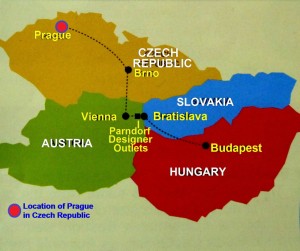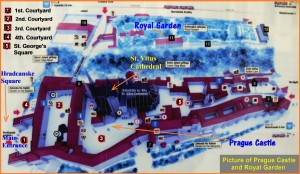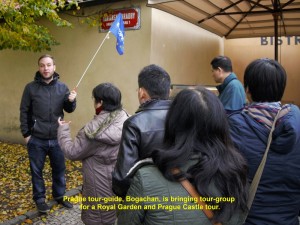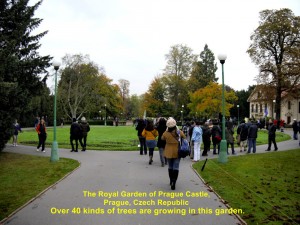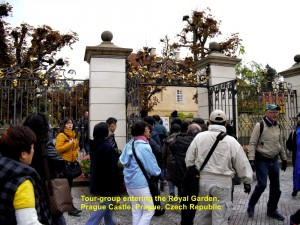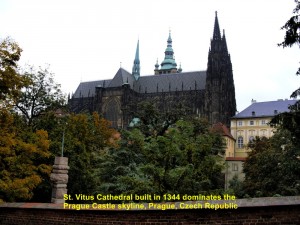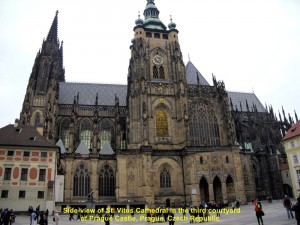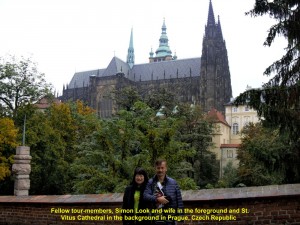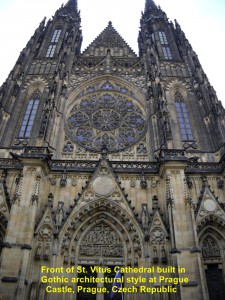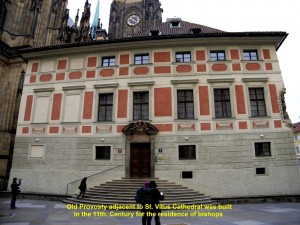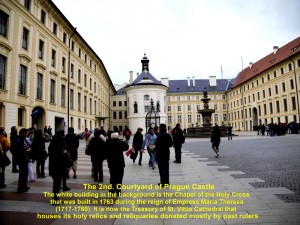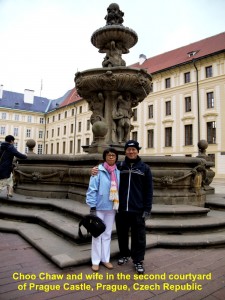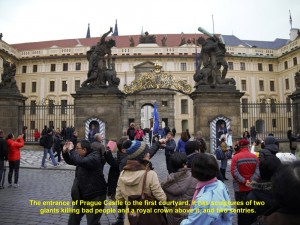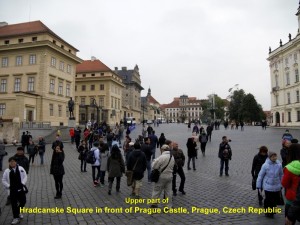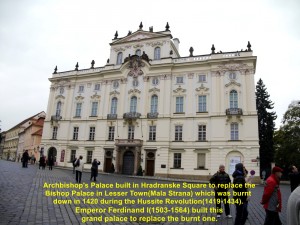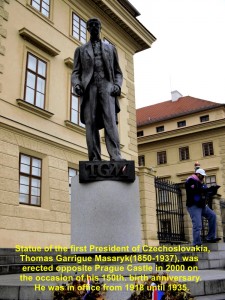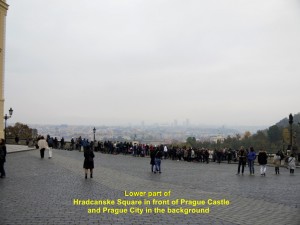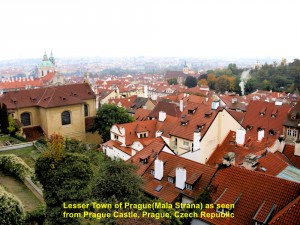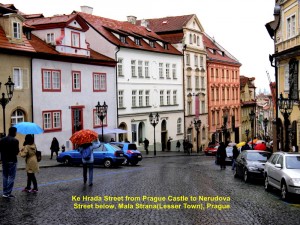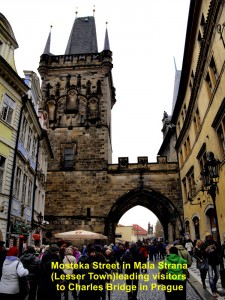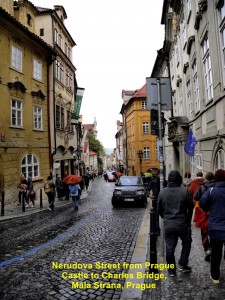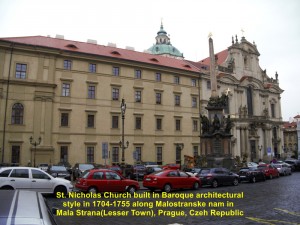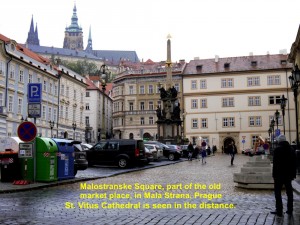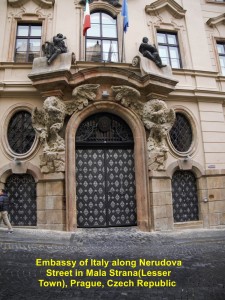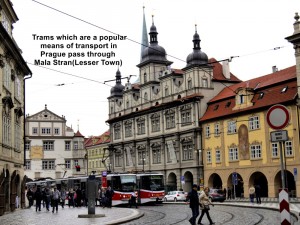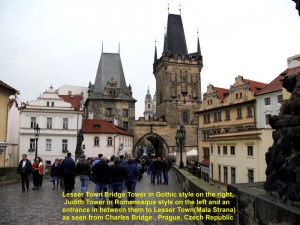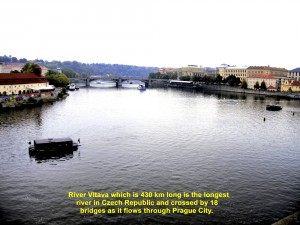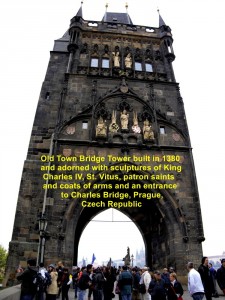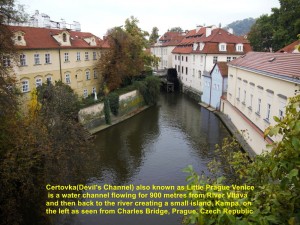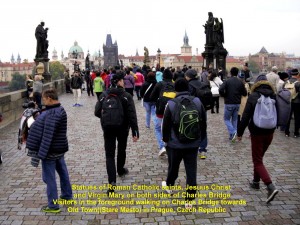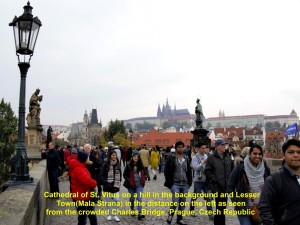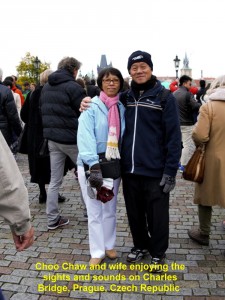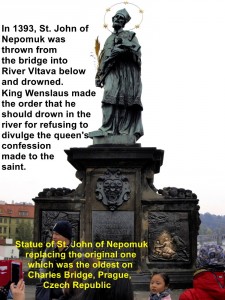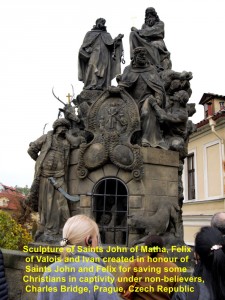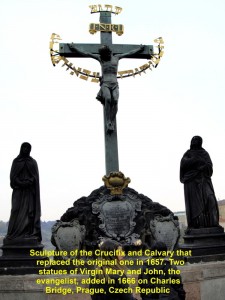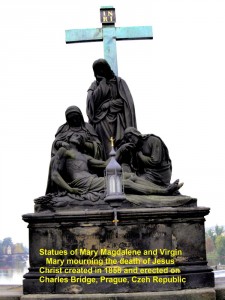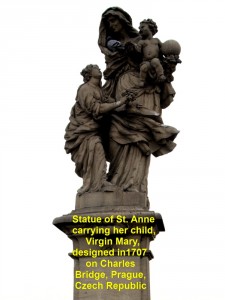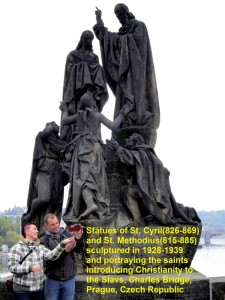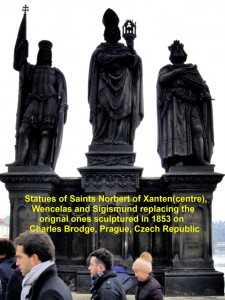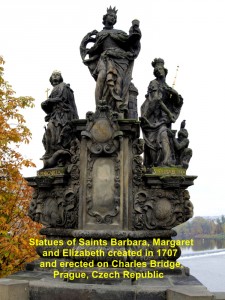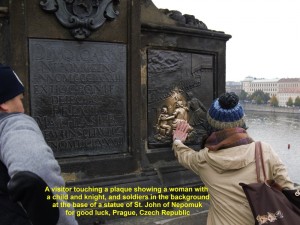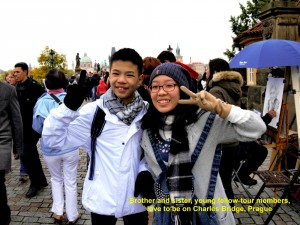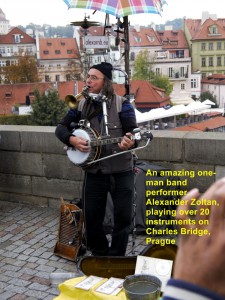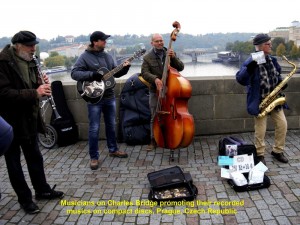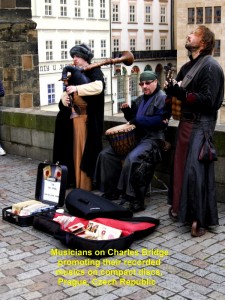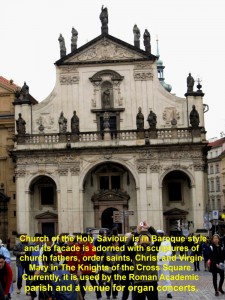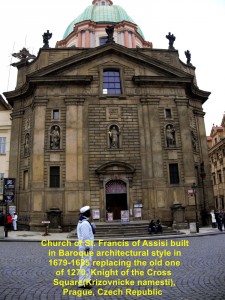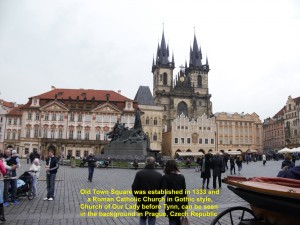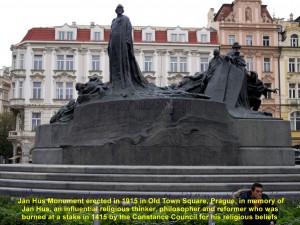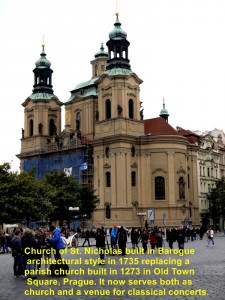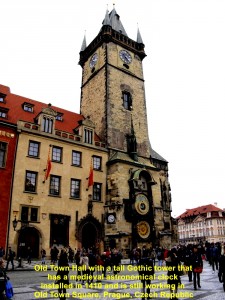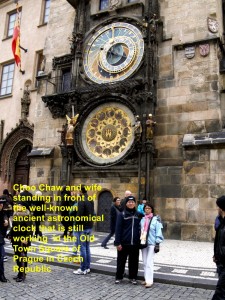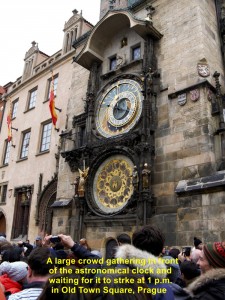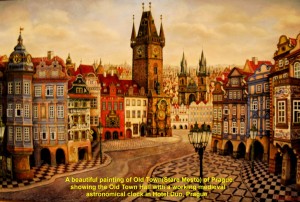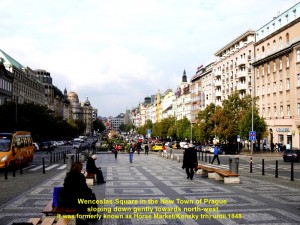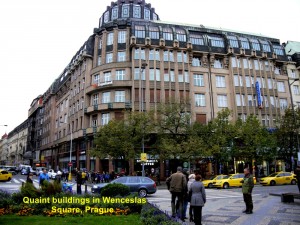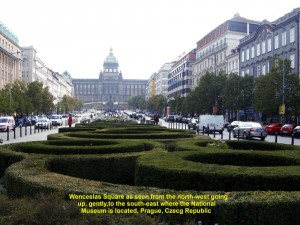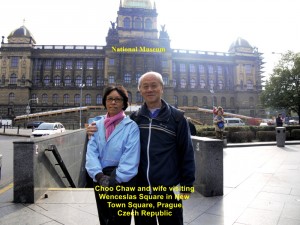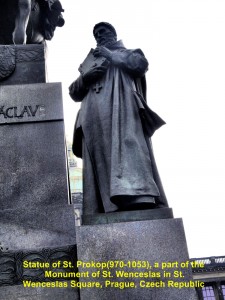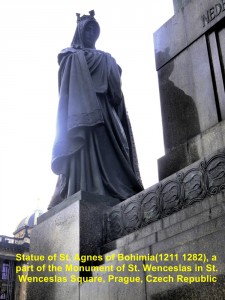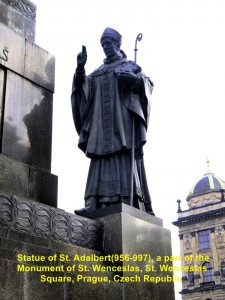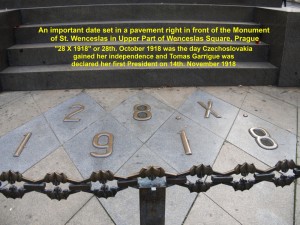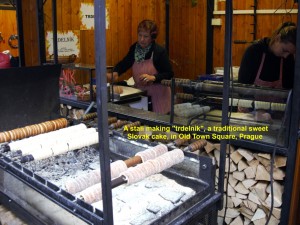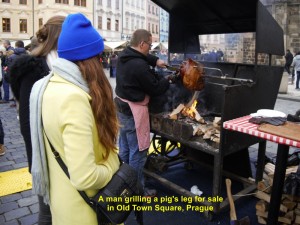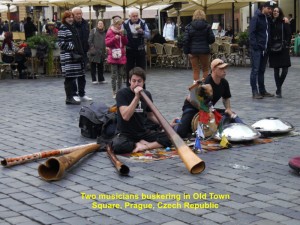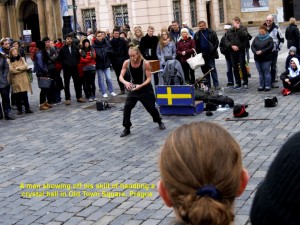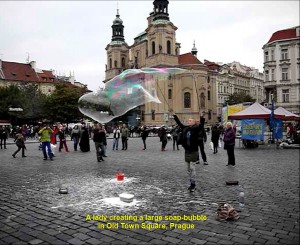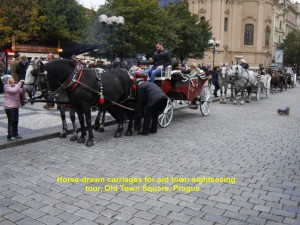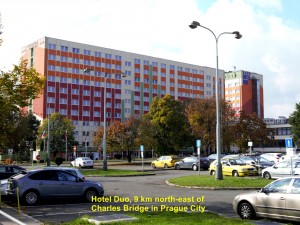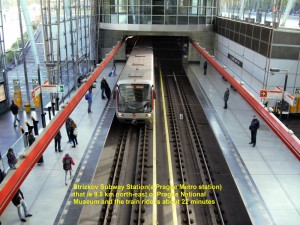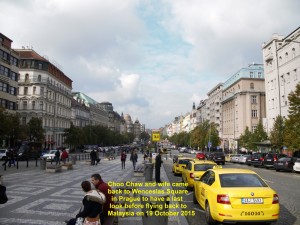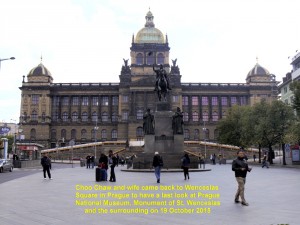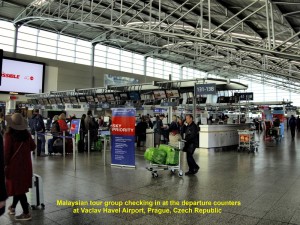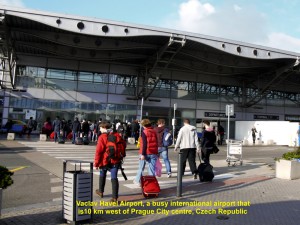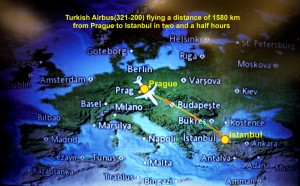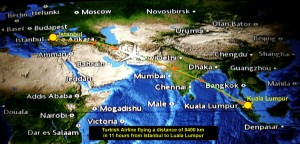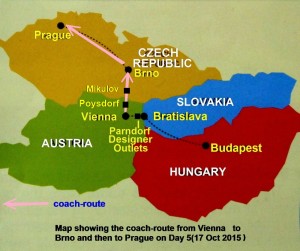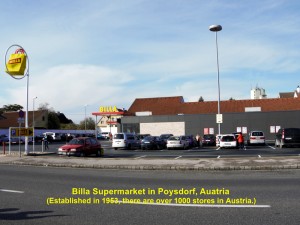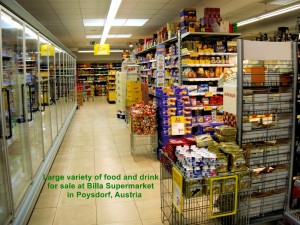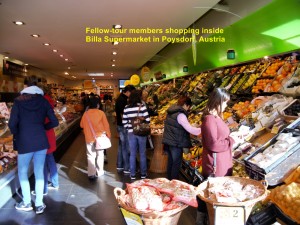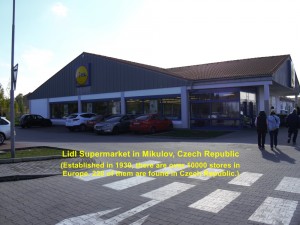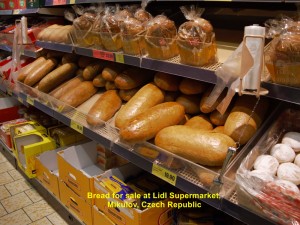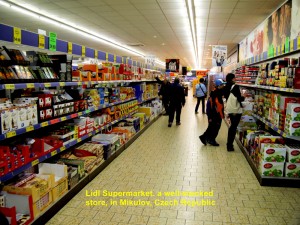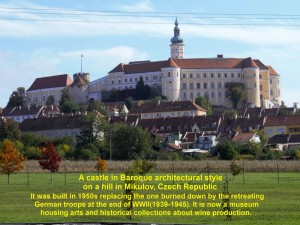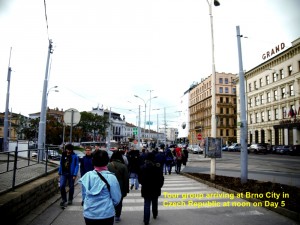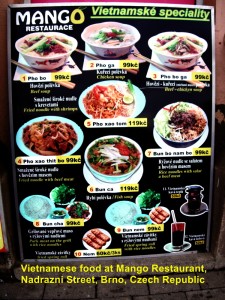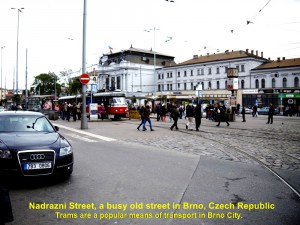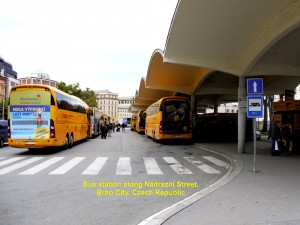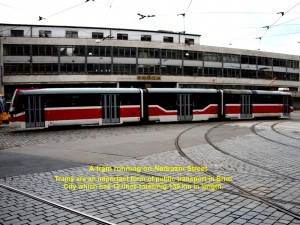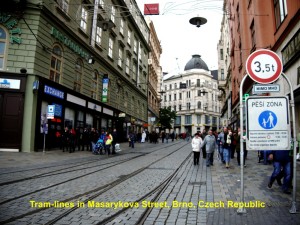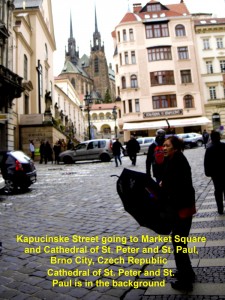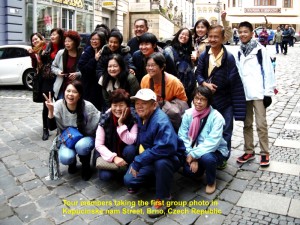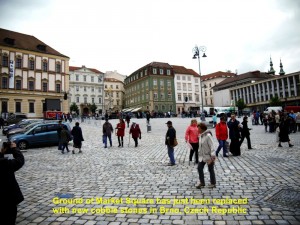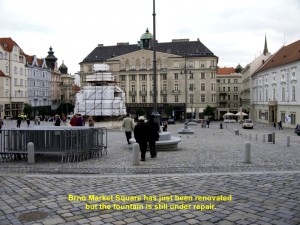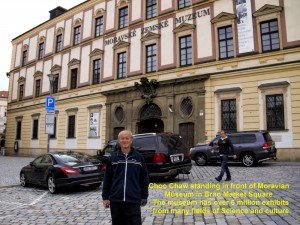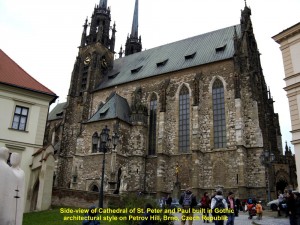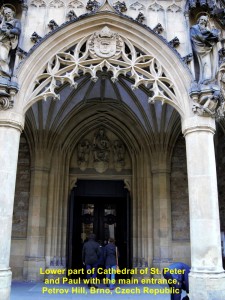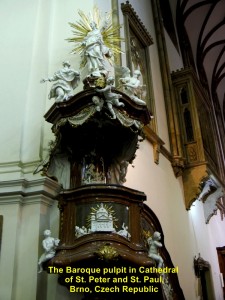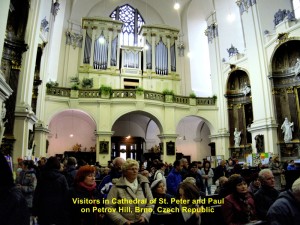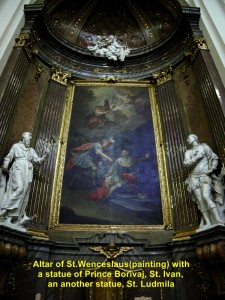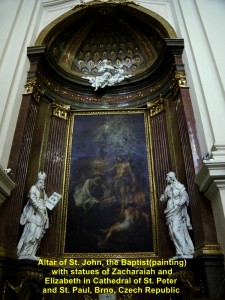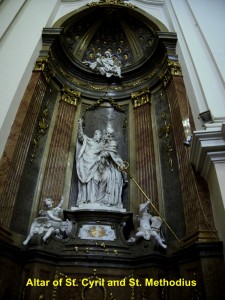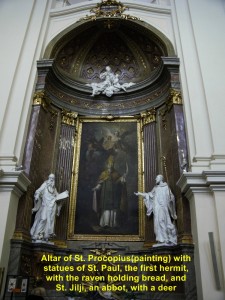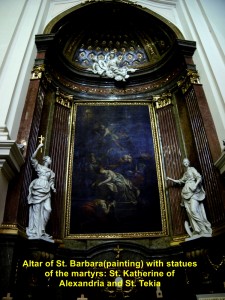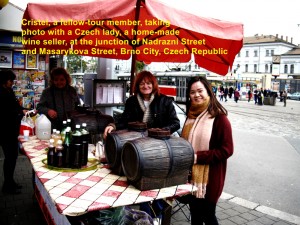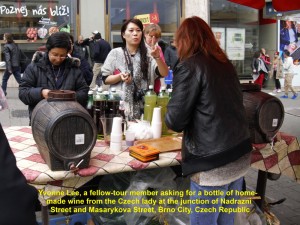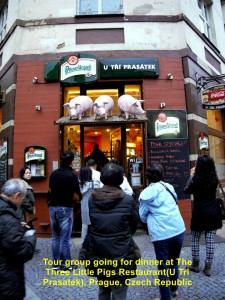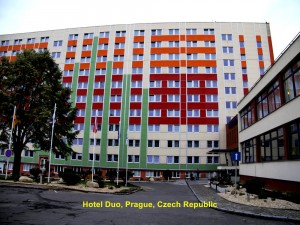Eastern Europe Travel Part VI(Prague)
Eastern Europe Travel Part VI(Prague)
Day 6 Sunday, 18 October 2015
Prague
Prague Castle
At 10 in the morning, we left our hotel, Hotel Duo, in Prague, Czech Republic, together with a local tour-guide, Bogachan, and went to the largest ancient castle in the world known as Prague Castle. It is 9 km south-west of the hotel. Its length is about 570 metres and average width 130 metres.
Below is a picture of Prague Castle and the Royal Garden:
Royal Garden of Prague Castle
Several minutes later, we arrived at the Royal Garden of Prague Castle along Marianske Hradby Road. Entering the garden, we saw over 40 kinds of plants growing there. It was established by a Holy Roman Emperor, Ferdinand I(1503-1564), in 1534.
Prague Castle for Past Rulers and Presidents
Then we walked up a hill for a short distance to the top where Prague Castle was sited. The castle was a residence for some kings of Bohemia, Holy Roman Emperors and Presidents of Czechoslovakia and Czech Republic. The history of the castle began in the 9th. Century.
Milos Zeman, the third and current President of Czech Republic who was elected in 2013, is staying at the castle.
St. Vitus Cathedral
There is a large cathedral that dominates the skyline of Prague Castle. It is located in the 3rd. courtyard of the castle. Known as St. Vitus Cathedral, it was built in 1344 in Gothic architectural style. The earliest church that was built on the same spot was founded in 930. Adjacent to the cathedral is a building, Old Provosty, that was built in the 11th. Century as a residence for the bishops.
WWI Monument
In the same courtyard, there is a tall, slim granite monument erected in 1928 in memory of the victims of World War I(1914-1918) and the independence of Czechoslovakia in 1918.
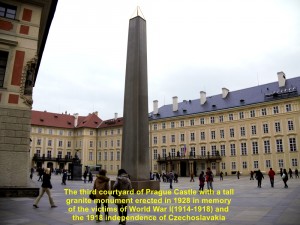
A tall monument erected in 1928 near St. Vitus Cathedral in the 3rd. courtyard in memory of the victims of WWI and 1918 Czechoslovakia Independence
Chapel of the Holy Cross
In the second courtyard, there is a white building in classical style known as Chapel of the Holy Cross. It was built in 1763 during the reign of Empress Maria Theresa(1717-1780). It is also the Treasury of St. Vitus Cathedral that houses the holy relics and reliquaries donated mostly by past rulers.
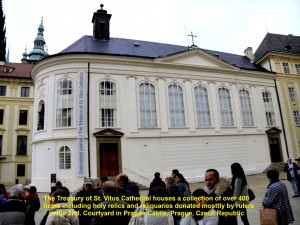
The Chapel of the Holy Cross is also the Treasury of St. Vitus Cathedral in the 2nd. courtyard of Prague Castle
Main Entrance of Prague Castle
The main entrance of Prague Castle is a large gate with two huge sculptures of giants killing bad people, one on each side, and a high royal crown structure in between them. There are two sentries guarding the entrance. This entrance leads to the 1st. courtyard and then the residence of the President of Czech Republic.
Hradcanske Square
In front of Prague Castle is an open-air area known as Hradcanske Square. It slopes down, gently, towards Ke Hrada Street.
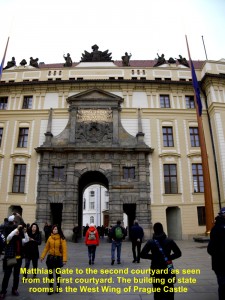
1st. courtyard of Prague Castle and the Matthias Gate to the 2nd. courtyard of Prague Castle, Prague
Archbishop’s Palace
A grand, white building known as Archbishop’s Palace, is easily noticeable in the square. It was built by Emperor Ferdinand I(1503-1564) in 1420 to replace the one that was burnt down in Mala Strana(Lesser Town) during the Hussite Revolution(1419-1434).
Statue of Thomas Garrigue Masaryk
Erected in 2000 opposite Prague Castle is a statue of the first President of Czechoslovakia, Thomas Garrigue Masaryk(1850-1937), on the occasion of his 150th. birth anniversary. He was in office as President from 1918 until 1935.
View of Mala Strana(Lesser Town)
From the lower part of Hradcanske Square, we saw a breathtaking view of an old town known as Mala Strana(Lesser Town). It has narrow streets lined with quaint buildings. Most of the building are in Baroque architectural style. Some of them have become embassies, hotels, museums and restaurants.
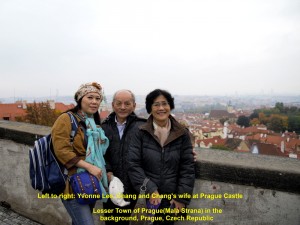
Fellow-members on the lower part of Hradcanske Square and Mala Strana(Lesser Town) in the distance, Prague
Pickpockets in Prague Castle
At 11.30 a.m. before we left Prague Castle for Mala Strana{Lesser Town), one of our tour-members realised that his wallet was lost to a pickpocket in one of the courtyards of the castle. He had lost some money and a visa card which he had to inform a bank in Malaysia for immediate cancellation. Before we began our EasternEurope, we were forewarned of pickpockets at crowded tourist places by our tour-manager, Joyanne Wong.
Pristine Mala Strana(Lesser Town)
Then we walked down a steep road, Ke Hrada Street, along Nerudova Street, Malostranske Street and Mostecka Street in Mala Strana(Lesser Town) before we reached the iconic bridge known as Charles Bridge.
Important Buildings in Mala Strana
Mala Strana was founded by King Ottokarll of Bohemia in 1257 and became a royal town. In 1419-1420 it was burnt down by Hussites and in 1541 it was burnt down again by a big fire. After the latter fire, many buildings in Baroque architectural style were built in the town.
While walking along Nerudova Street and Malostranske Street in the pristine town, we came across some important buildings including St. Nicholas Church, embassies of Italy, Romania and Paraguay, and a former market place now known as Malostranske Square.
Trams in Mala Strana(Lesser Town)
Trams are a popular means of transport in Prague City. In 1875 horsecar trams were introduced in Prague. Then in 1891 they were replaced by electric trams.
The tramway network in Prague City is the largest in the country, Czech Republic. They pass through Mala Strana(Lesser Town), too.
Charles Bridge, Prague
We took about 25 minutes to walk from Prague Castle to Charles Bridge. The bridge is the oldest and most iconic one among the 18 bridges that cross River Vltara in Prague.
Construction of the bridge began in 1357 during the reign of Charles IV and completed in 1402. It is about 520 metres long and 10 metres wide connecting Lesser Town(Mala Strana) and Old Town(Stare Mesto).
Statues on Charles Bridge
Around the year 1700, 30 sculptures of Roman Catholic saints were erected on both sides of the bridge. As the nation wanted to preserve the original sculptures for posterity, they were all removed since 1965, systematically, to National Museum in Prague New Town.
Replicas were used to replace the original ones on the bridge.
Little Prague Venice
A small water channel of 900 metres long, Certovka(Devil’s Channel) also known as Little Prague Venice on the side of Mala Strana(Lesser Town), can be seen from Charles Bridge.
Photos of Statues on Charles Bridge
While fellow-members and I were strolling the whole length of the bridge on Sunday, 18 October 2015, we saw many visitors and some music-buskers on the bridge. Many of us and visitors would stop in front of a few sculptures to take photos.
Here are some photos of the sculptures of important religious figures of the past erected on Charles Bridge, Prague:
i. Statue of St. John of Nepomuk is the oldest statue on the bridge. The saint was thrown from the bridge into the river and drowned because he refused to divulge the queen’s confession to the king, King Wenceslas.
ii. Sculpture of the Crucifixion and Calvay and two statues of Virgin Mary and John, the Evangelist were added in 1666.
iii. Statues of Saints John of Matha, Felix of Valois and Ivan It was created in honour of Saints John and Felix for saving some Christians who were captured by non-believers.
iv. Statues of Marry Magdalene and Virgin Mary mourning the death of Jesus Christ. They were created in 1858.
v. Statues of Saints Cyril(826-869) and Methodius(815-885) introducing Christianity to the Slavs created in 1928-1939
vi. Statue of St. Anne carrying her child, Virgin Mary. It was created in 1707.
vii. Statue of St. Ludmilla with her grandchild, Wenceslas created in 1730
viii. Statues of Saints Nobert of Xanten, Wenceslas and Sigismund created in 1853
ix. Statues of Saints Barbara, Mary and Elizabethcreated in 1835
An Odd Statue
There is one odd statue on a pillar planted in River Vltara and beside Charles Bridge. It is a statue of a mythical knight, Bruncvik. According to local legend, he helped a lion to fight a 7-headed dragon. This statue was sculptured in 1884 replacing the original one which was created in 1502 and then destroyed by the Swedish forces in 1648.
Rubbing Two Bronze Plagues for Good Luck
Visitors like to touch or rub two bronze plaques on a pedestal of a statue for good luck. It is the Statue of St. John of Nepomuk. One of its plaques shows a woman with a child and knight and the other a knight with a dog. They have been touched or rubbed so frequently that they become shining.
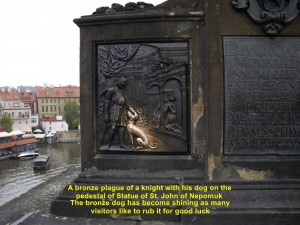
A bronze plaque on the pedestal of Statue of St. John of Nepomuk has become shining after frequent rub by visitors.
Alexander Zoltan, a One-Man Band
There were some music-buskers on Charles Bridge. They made the atmosphere of religious sentiment over the bridge lively. Thanks to them.
Among the buskers on the bridge, there was one that caught my attention. He was amazing as he had over 20 musical instruments on his body, including banjo, harmonica, duck call, washboard, cymbal, cow-bell, bicycle-bell and tambourine to name a few. He could play several of them at the same time. He is a one-man band and well-known worldwide. He is none other than Alexander Zoltan who was born in Prague.
Photos of Musicians on Charles Bridge
Here are three photos showing some musicians on Charles Bridge:
Knights of the Cross Square(Krizoynicke namesti)
Soon we stepped out of Charles Bridge on the side of Old Town(Stare Mesto) and entered a small open-air space known as Knights of the Cross Square(Krizoynicke namesti). Around this square are some important buildings, including the following:
i. Charles Museum with a statue of Charles IV(1316-1378), a Holy Roman Emperor, erected in front in 1848 on the occasion of the 500th. anniversary of Charles University.
ii. Church of St. Francis of Assisi built in Baroque architectural style in 1679-1685 replacing the old one of 1270.
iii. Church of the Holy Saviour built in Baroque architectural style with a facade adorned with sculptures of church fathers, order saints, Jesus Christ and Virgin Mary. Currently, it is used by the Roman Academic Parish and a venue for organ concerts.
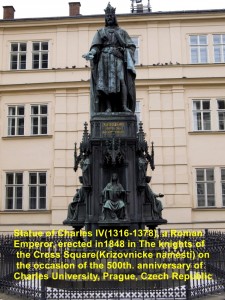
Statue of Charles IV in front of Charles Museum, Knights of the Cross Square, Old Town(Stare Mesto), Prague
Old Town Square, Prague
From the Knights of the Cross Square(Krizoynicke namesti) we walked into another open-air space which is larger nearby. It is known as Old Town Square which was established in 1333.
Jan Hus Monument
In the middle of the square is a large monument, Jan Hus Monument. It was erected there in 1915 in memory of Jan Hus(1369-1415) who was burned to death at a stake in 1415 by the Constance Council for his religious beliefs. Jan Hus was an influential religious thinker, philosopher and reformer.
Church of Old Lady before Tynn
Around the Old Town Square are shops, restaurants hotels, Old Town Hall and and churches. There are two large churches built in different architectural styles. One known as Church of Old Lady before Tynn was built in the 14th. Century in Gothic architectural style. It is the most dominant building in the area as it has two 80 metre-high towers.
Church of St. Nicholas
The other church, Church of St. Nicholas, was built in 1735 in Baroque architectural style replacing the old one that was built in 1273. It now serves both as a church and venue for classical concerts.
Medieval Astronomical Clock, Old Town Hall
But the most interesting building in the square is the Old Town Hall. It has a tall tower with a unique medieval astronomical clock, Orloj, installed in 1410. The clock is still working.
It is made up of three components: the astronomical dial representing the position of the sun and moon, a calendar dial with medallions representing the months, and “The Walk of Apostles” that makes the figures of apostles appear hourly.
1 p.m. Time Show of Astronomical Clock
A few minutes before 1 p.m. we saw a large crowd gathering in front of the astronomical clock and waiting, patiently, for it to strike at 1 p.m.. We, too, joined them. At 1 p.m. the clock rang, continuously, and two small windows above it opened showing small figures of apostles moving inside. Several seconds later, the windows closed and the clock struck several times. Then it was all over and the crowd dispersed. The next time it would ring again was 2 p.m.
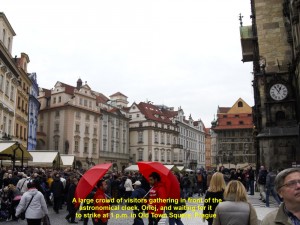
A large crowd gathering in front of the astronomical clock waiting for it to strike at 1 p.m., in Old Town Square, Prague
Wenceslas Square
After the astronomical clock show, we walked to another square nearby. Known as Wenceslas Square, it is a busy place where visitors are attracted to quaint and modern buildings which are now hotels, restaurants, shops, offices, etc.. Important celebrations and gatherings are often held there. Many political events have happened in the square.
Wenceslas Square was formerly known as Horse Market(Konsky trh) until 1848 when it was changed to the current name.
Velvet Revolution
Velvet Revolution was one of the significant political events that happened in 1989. Students and older dissidents demonstrated against the one-party government of the Communist Party of Czechoslovakia in Wenceslas Square and other places in 1989. Consequently, the 41 year-old communist rule in Czechoslovakia ended and, subsequently, it became a parliamentary republic.
National Museum, Prague
The large building built in 1885-1891 in neo-Renaissance architectural style on the upper part of Wenceslas Square is the National Museum. It houses about 14 million items from many different areas, including natural history, history, arts and music. It is closed for renovation until 2017.
Jan Palach and Jan Zajic
In the middle of the square, there is a small area in a garden that is dedicated to two Czech students, Jan Palach(1948-1969) and Jan Zajic(1950-1969). They burned themselves to death on separate occasions in Wenceslas Square in protest against Soviet Union’s invasion and occupation in their country, Czechoslovakia, in 1969
A proper monument of the two martyrs is created in the form of a bronze cross set in the ground in front of National Museum located on the upper part of the square.
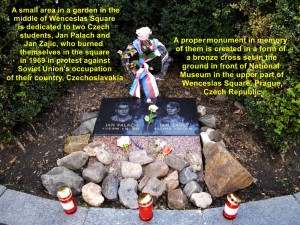
A monument in the middle of Wenceslas Square in memory of 2 Czech students who burned themselves in the square in 1969
Monument of St. Wenceslas
A monument of St. Wenceslas(907-935) mounting a horse was erected in the upper square in memory of him as a martyr. While he was Duke of Bohemia he was invited by his cruel brother, Boleslav, to a feast and murdered by the latter’s three friends in 935. The monument was sculptured by Josef Vaclav Myslbek in 1887-1924.
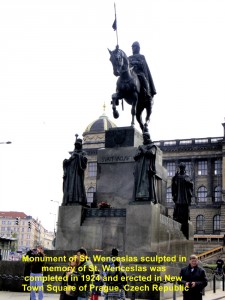
Monument of St. Wenceslas mounting a horse and 4 saint statues at its base, Wenceslas Square, Prague
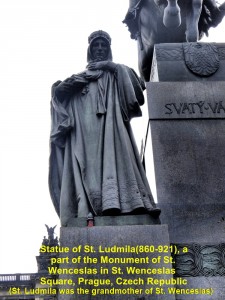
Statue of St. Ludmila(St. Wenceslas’ grandmother) at the base of the Monument of St, Wenceslas, Prague
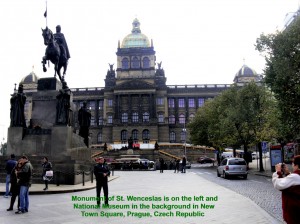
Monument of St. Wenceslas on the left and National Museum in the background, Wenceslas Square, Prague
Statues at Monument of St. Wenceslas
Four statues were later added to the base of the monument, viz. St. Ludmila(860-921) who was St. Wenceslas’ grandmother, St. Prokop(970-1053), St. Adalbert(956-997) and St. Agnes of Bohemia(1211-1282)
“28 X 1918”
“28 X 1918” is a significant date, 28th. October 1918, set in the pavement right in front of the Monument of St. Wenceslas. It was the day Czechoslovakia gained its independence. On 14th. November 1918, Tomas Garrigue Masaryk became her first President.
Old Town Square(Stare Mesto)
At about 4 p.m. we left Wenceslas Square and walked back to Old Town Square which was nearby. We spent about two hours in the square.
Trdelnik
In the square we watched a stall making trdelnik which is a traditional Slovak cake. It is made from dough that is wrapped around a long cylinder, then grilled and coated with a mixture of sugar and walnuts.
Grilled Pork
Next to that stall was one that was selling grilled leg of a pig. The owner was cutting it into pieces while customers were waiting for to buy the meat.
Street Performers
There were a few street performers in the square. We saw musicians playing different instruments, a man playing with a crystal ball and making it roll all over his body, smoothly, and a lady creating large soap-bubbles, effortlessly.
Horse-Drawn Carriages for Old Town Tour
There were some horse-drawn carriages in the square carrying visitors around the Old Town of Prague for a sightseeing tour.
Newly-Married Couple from China
An interesting event was taking place in front of the astronomical clock in Old Town Square at about 6 p.m.. A professional photographer was busy taking photos of a newly-married couple from China in front of the clock. They were wearing modern wedding clothes. After the photoshoot, the bride turned her back, threw her bouquet of flowers to a group of ladies standing behind her and one of them caught it with happiness.
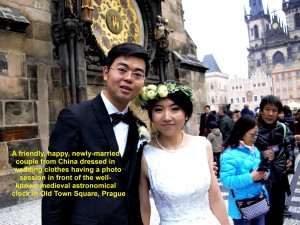
A newly-married couple from China posing in front of the medieval astronomical clock in Old Town Square, Prague
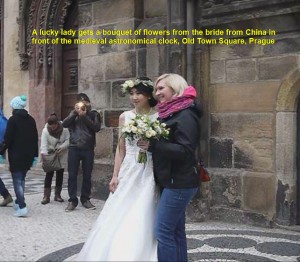
A lucky lady caught a bouquet of flowers from the bride next to her in front of the astronomical clock in Old Town Square, Prague
Dinner
At 6.30 p.m. we all left Old Town Square and headed to a restaurant for dinner. After dinner we went back to our hotel, Hotel Duo, in Strizkov, where we stayed for the last night.
Day 7 Monday, 19 October 2015
Day 7 was our last day in Prague and Eastern Europe. We would fly back from Prague airport to our country, Malaysia, via Istanbul at 7.10 in the evening.
Since we had a lot of time to wait for the departure, my wife and I decided to go back to Wenceslas Square in Prague New Town to have a last look.
Last Visit to Wenceslas Square
To go to the square by ourselves, we bought Metro tickets from our hotel, Hotel Duo, in Strizkov and walked to a Metro station nearby. At 11.45 a.m we boarded a train and left for Muzeum Station in Wenceslas Square. Twenty minutes later we arrived at the station and spent two hours in the square enjoying the sights of the square again.
Departure for Home in Malaysia
Vaclav Havel International Airport, Prague
At about 3 p.m. we left the hotel and went to Vaclav Havel International Airport(named after the first President of Czech Republic), which is 9 km west of Prague. On arrival at the airport, we, sadly, bade farewell to our friendly coach-driver, John, who had, diligently, brought us to some cities in Hungary, Slovakia, Austria and Czech Republic for sightseeing tours for six days. Then we checked in at the airport and waited for few hours to fly home.
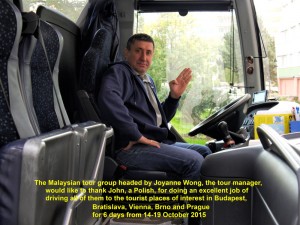
Malaysian tour-group thanking John for bringing them around in the eastern European countries from 14-19 October 2015
Ataturk International Airport, Istanbul
At 7.10 p.m. we boarded a Turkish airline and flew 1500 km from Prague to Ataturk International Airport in Istanbul, Turkey, in 2 hours and 20 minutes. On arrival at the airport, we disembarked and stayed there waiting for a few hours for another Turkish airline.
A Malaysian Member of Parliament
At 1.15 a.m. we got onto another Turkish airline and were, pleasantly, surprised to see a Member of Parliament from our country in the same economy class as us. She is Honorable Nurul Izzah Anwar, the Member of Parliament for Pantai Lembah.
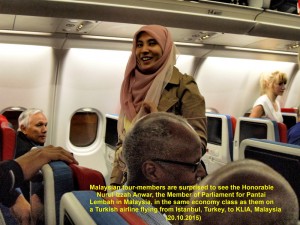
Honorable Nurul Izzah Anwar, Member of Parliament for Pantai Lembah in Malaysia on a Turkish airplane
(She and other Malaysian political leaders met in Bosphorus in Turkey to make a declaration: “The Bosphorus Declaration on Saving Malaysia”, on 17.10.2015 urging “Malaysians to unite to save Malaysia from the divisive politics of race, religions, extremism and intolerance. ………”. (You may find more information on this declaration on Honorable Nurul Izzah’s website: http://www.nurulizzah.com/…/the-bosphorus-declaration-on-s…/ ))
Soon our plane took off from Istanbul airport and flew all the way to our homeland, Malaysia.
Home Sweet Home
It took about 11 hours to travel a long distance of 8400 km from Istanbul to Kuala Lumpur International Airport(KLIA) in Malaysia. At 4.30 p.m. we arrived at the Malaysian airport, finally. Thanks to Turkish Airlines for the safe journey.
That was an unforgettable tour in Eastern Europe from 13-20 October 2015. It was a tour that our tour-members, my wife and I have enjoyed very much.
(Written by Choo Chaw, Kluang, Johor, Malaysia)
Eastern Europe Travel(13-20 October 2015):
Part II(Bratislava & Pandorf Designer Outlet)
Acknowledgement:
Here we would like to thank the following for making our trip a successful and memorable one:
i. Joyanne Wong, tour-manager of Golden Destinations Tour Agency, Kuala Lumpur.
ii. Vacation Hub, Johor Bahru
iii. Kinga Szabo, Budapest guide
iv. Michael, Vienna guide
v. Bogachan, Prague guide
vi. John, coach-driver
Thanks to our fellow-tour members, too, for being wonderful companions.
Eastern Europe Travel Part V(Brno)
Eastern Europe Travel Part V(Brno)
Day 5 Saturday, 17 October 2015
Brno
At 9 a.m. we left Vienna in Austria and headed north for Brno, the second largest city in Czech Republic, which is 134 km away to see an old neo-Gothic cathedral known as Cathedral of St. Peter and Paul located on a hill, Petrov Hill.
Supermarkets
On the way we made two stops for tea and shopping, Billa Supermarket at Poysdorf in Austria and Lidl Supermarket at Mikulov in Czech Republic, before we reached Brno at about 1 p.m..
Billa and Lidl Supermarkets
Established in 1953, there are over 3600 Billa stores in Europe. Over 1000 of them are found in Austria. Lidl Supermarket was founded in 1930 and now there are over 10000 stores in Europe including 220 in Czech Republic.
Mikulov Castle
At Mikulov I saw a castle on a hill. It was constructed in the 1950s replacing the old one that was burnt down by the retreating German troops at the end of WWII(1939-1945). It is now a museum housing art and historical collections related to the history of wine production.
Lunch in Brno
On arrival at Brno at about noon, we had lunch at restaurants of our choice which were along a busy street, Nadrazni Street. My wife and I had to change some Euro dollars for the local currency, Czech crown or koruna, at a money-exchange kiosk before we could buy a meal. Then we decided to have Vietnamese food for lunch at a Vietnamese restaurant, Mango Restaurant.
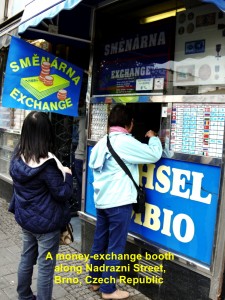
Choo Chaw’s wife changing Euro dollars to Czech crowns at a money-exchange booth, Nadrazni Street, Brno, Czech Republic
Electric Trams in Brno
After lunch all the tour-members gathered at the junction of Nadrazni Street and Masarykova Street. From the junction I noticed that electric trams were a common sight along Nadrazni Street. Trams are an important means of public transport in Brno City. There are 12 tram-lines in the city and some are connected to nearby towns totalling 139 km in length. There is a bus-station along Nadrazni Street.
Group Photo
After the head count, our tour manager, Joanne Wong, led us to a large cathedral, Cathedral of St, Peter and Paul, on Petrov Hill. First, we walked along Masarykova Street. Then we turned left into Kapucinske nam Street where we stopped for awhile to have a group photo taken. From that street we could see the well-known cathedral in the distance.
Market Square in Brno
Kapucinske nam Street led us to a large square, Market Square, with newly replaced cobblestone ground. Old quaint buildings surrounded the square. They had become restaurants, hotels, shops, theatres and museums.
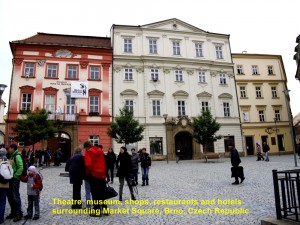
Quaint buildings of shops, restaurants, hotels and museums surrounding Market Square, Brno City, Czech Republic
Sculptures in Market Square
In the square there was a fountain which was under repair. Near the fountain was a sculpture of the Holy Trinity. Besides, there was a black sculpture of a little boy, Wolfgang A. Mozart, atop a high column in front of a theatre, Reduta Theatre, where Mozart who was 17-years old and his sister performed together in 1767.
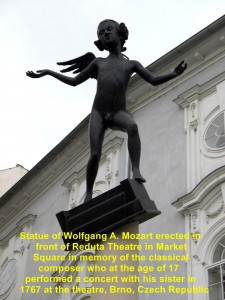
Sculpture of a boy, Wolfgang A. Mozart, in front of Reduta Theatre, Market Square, Brno City, Czech Republic
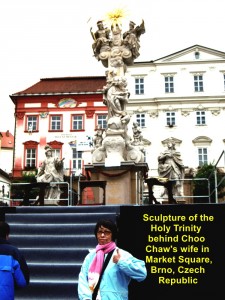
Choo Chaw’s wife in Market Square and a sculpture of the Holy Trinity in the background, Brno City, Czech Republic
Capuchin Church
Near the square there was a yellow church, Capuchin Church, decorated outside with Baroque sculptures created in 1765 and having several mummified bodies of monks and devotees in its cellar.
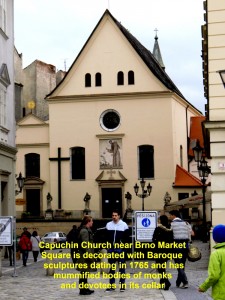
Capuchin Church with Barogue sculptures outside and mummified bodies in its cellar, Market Square, Brno City, Czech Republic
Cathedral of St. Peter and St. John
Walking up a slope on Petrov Hill and away from Market Square we came to a few flights of steps that led visitors to Cathedral of St. Peter and Paul. When we reached the top of the hill we saw the cathedral. It was large and old. Built in neo-Gothic architectural style at the end of the 19th. Century, it had two 84-metre high towers. Its interior retained the Baroque architectural style.
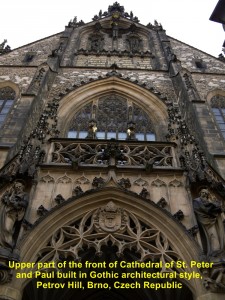
Upper part of the facade of Cathedral of St. Peter and St. Paul, Petrov Hill, Brno City, Czech Republic
Retreat of Swedish Army
In 1646, Brno city was saved by the cathedral’s bells which rang at 11 o’clock instead of 12 noon. Legend has it that the Swedish general, Tornstenson, would give up Brno City if it was not captured by midday. But the crafty leader of the defending army requested the bells to be rung at 11 o’clock which was one hour earlier. So the Swedish army who were fooled by the bells left Brno without capturing it. Since then the cathedral’s bells are ringing at 11 o’clock to commemorate the happy occasion.
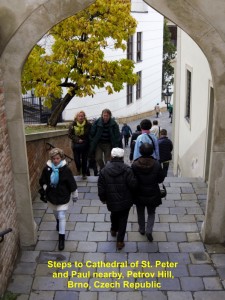
Steps from Market Square to Cathedral of St. Peter and St. Paul on Petrov Hill, Brno City, Czech Republic
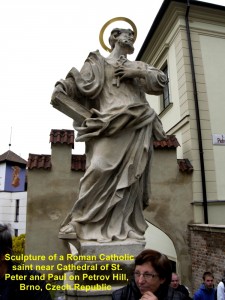
Statue of a saint at the top of the steps to Cathedral of St. Peter and St. Paul on Petrov Hill, Brno City, Czech Republic
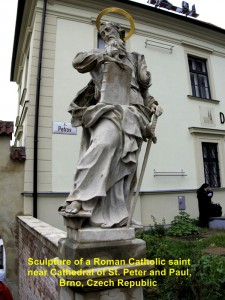
Statue of a saint on the top of the steps to Cathedral of St. Peter and St. Paul, Petrov Hill, Brno City, Czech Republic
Sculptures outside the Cathedral
Outside the cathedral, I saw some sculptures, including two separate statues of saints at the upper part of the steps, a simple sculpture of two saints who were brothers(Cyril(826-869) and Methodius(815-885)) and Crucifixion of Jesus Christ.
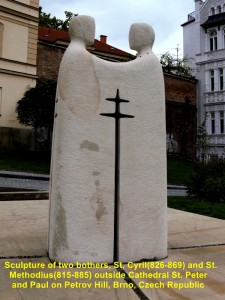
Sculpture of two brothers, St. Cyril and St. Methodius, near Cathedral of St. Peter and St. Paul, Petrov Hill, Brno City, Czech Republic
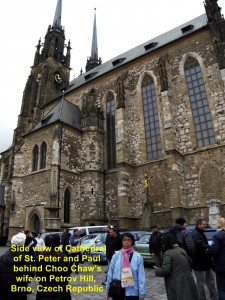
Choo Chaw’s wife outside Cathedral of St. Peter and St. Paul, Petrov Hill, Brno City, Czech Republic
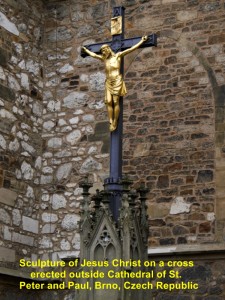
Sculpture of the Crucifixion of Jesus Christ outside Cathedral of St. Peter and St. Paul, Petrov Hill, Brno City, Czech Republic
Cathedral Interior
When we entered the cathedral we saw many visitors watching a drama about the life of Jesus Christ at the main altar. With my camera, I went round inside the cathedral taking some photos of the interior, statues and paintings featuring saints and Jesus Christ at small altars. The the ceiling was high and curved.
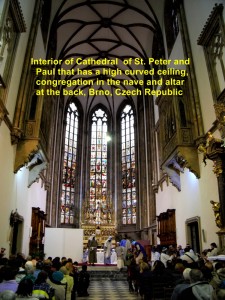
Interior of Cathedral of St. Peter and St. Paul with high, curved ceiling, Petrov Hill, Brno City, Czech Republic
Altars in Cathedral
Photos of the altars in Cathedral of St. Peter and St. Paul are shown below:
Three more photos of the altars in Cathedral of St. Peter and St. Paul are shown below:
Back to Nadrazni Street
We left Cathedral of St. Peter and St. Paul at 2.30 p.m. after spending a short time at the cathedral to see its structure and learn about its history. We walked back to Nadrazni Street and waited for our coach. While we were waiting at a junction some of our fellow-members bought some home-made wine from a street vendor.
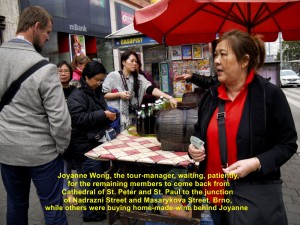
Joyanne Wong, tour-manager, waiting for the remaining members to come back from Cathedral of St. Peter and St. Paul, Brno City
Travel to Prague
At 3 p.m our coach arrived and took us to the next city, Prague, which is 204 km north-west of Brno. It is the capital of Czech Republic and home to about 2 million people.
Three Little Pigs Restaurant, Prague
At 6 p.m. we arrived at a restaurant in Prague City for dinner. It was known as Restaurant U Tri Prasatek or Three Little Pigs Restaurant located along Vinohradska Street.
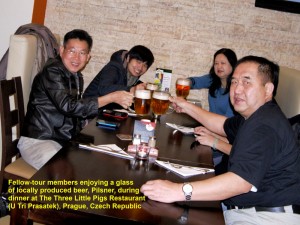
Fellow tour-members having a glass of locally-made beer, Pilsner, during dinner at Three Little Pigs Restaurant, Prague, Czech Republic
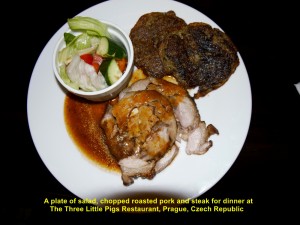
A plate of salad, chopped roasted pork and steak for dinner at Three Little Pigs Restaurant, Prague, Czech Republic
Before entering the restaurant, we were fascinated by three little, white pig-figures at the top of the entrance. They gave the name of the restaurant. At the restaurant we were served a plate of salad, chopped roasted pork and steak.
Pilsner Beer, Czech’s Beer
Some fellow-members enjoyed drinking Pilsner beer. The beer was first produced in 1842 in Plzen or Pilsen which is 90 km west of Prague in Czech Republic and takes its name from the city. It is now well-known worldwide. A Bavarian brewer, Josef Groll(1813-1887), created the beer.
Hotel Duo
After dinner we went to a hotel, Hotel Duo in the outskirt of Prague City, where we would stay for two nights.
Eastern Europe Travel(13-20 October 2015):
Part II(Bratislava & Pandorf Designer Outlet)

